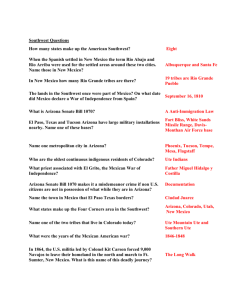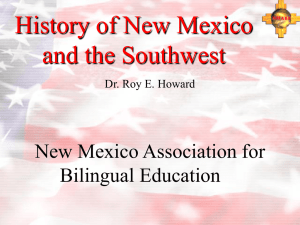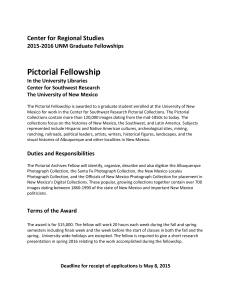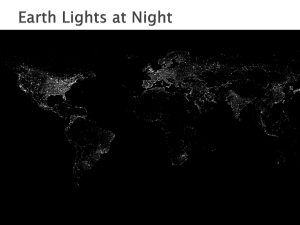Southwest Study Guide - Metropolitan State University of Denver
advertisement
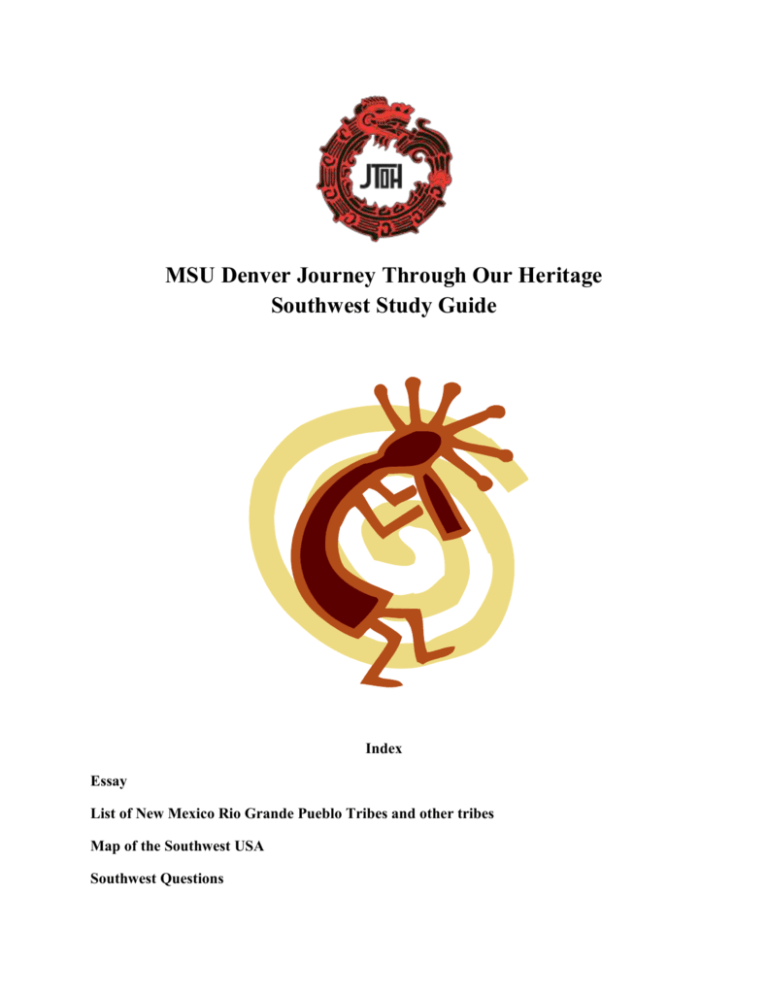
MSU Denver Journey Through Our Heritage Southwest Study Guide Index Essay List of New Mexico Rio Grande Pueblo Tribes and other tribes Map of the Southwest USA Southwest Questions What is the Southwest? The Southwestern United States, in its broadest definition, includes nearly a quarter of the United States with a total population of roughly 19 million people. This region is populated by the largest concentration of Hispanics and Native Americans in the United States. It includes the eight states of California, Nevada, Arizona, New Mexico, Utah, Colorado, Oklahoma, and Texas. Pre Conquest/Colonization of Southwest What we refer to as the American Southwest prior to the 1500’s, had little contact with the tribes of what is now Mexico, except for sporadic trade. The area was virtually untouched by outside enemies. It was home to many indigenous tribal people who had lived in the area for hundreds of years. The conquest of Mexico during 1519-1521 led by the Spanish conquistador Hernan Cortez (who invaded the Aztec empire at Tenochtitlan (Mexico City)), had long term effects on the Southwest. Once the Spanish had established rule in the central portion of Mexico, they began to move north to expand their empire. In 1598 Don Juan de Oñate, established the first colony in the Southwest in what is now Española, New Mexico. On April 30, 1598, he claimed all of New Mexico beyond the Rio Grande River for Spain. Oñate had a reputation as a cruel ruler of both the Spanish colonists and the indigenous people of the Southwest. In October of 1598, a battle erupted when Oñate's occupying Spanish military demanded supplies from the Acoma Pueblo tribe. They claimed things that were necessary to the Acoma surviving the winter. The Acoma resisted and 13 Spaniards were killed, amongst them Don Juan Oñate’s nephew. In 1599, Oñate retaliated; his soldiers killed 800 villagers. They enslaved the remaining 500 women and children, and by Don Juan’s decree, they amputated the left foot of every Acoma man over the age of twenty-five. Eighty men had their left feet amputated. Mexican Independence and the Southwest The unrest among the native peoples of the Southwest at the hands of the Spanish leaders was mirrored in their Mexican counterparts to the south. In the early hours of September 16th, 1810 (El Grito), Miguel Hidalgo y Costilla, a priest in the small town of Dolores, Hidalgo, rang the church bell to gather the townspeople. He called for the people of Mexico to rise up against the Spanish Crown, thus initiating Mexico's War of Independence. The country did not achieve independence until 1821. It is this event, known as the Grito de Dolores which is commemorated every year in town squares across Mexico and the Southwest. Mexican American War /Southwest Between 1846 and 1848, two neighbors, the United States and Mexico, went to war. It was a defining event for nations, transforming a continent and forging a new identity for its people. By the war's end, Mexico lost nearly half of its territory (the present American Southwest). The United States with this acquisition became a continental power. The United States, fueled by new technological breakthroughs and inspired by the concept of "Manifest Destiny," confidently expanded its territories westward. Southwest Today The Southwest today can be divided into four separate sub regions: 1.“Northern New Mexico”, 2. “Central Arizona”, 3. “Southern Borderlands which include the border cities; El Paso in Texas (Juarez Ciudad) and Tucson in Arizona (Nogales)”, and 4. “Northern Corridor and Navajo lands”. This entire region includes many different features, primarily its clear and dry climate. There are broad flatlands in the lower Rio Grande Valley located in the southern part of Texas, plateaus in New Mexico, mesas, buttes, and deserts in Arizona, and the Sangre de Cristo Mountains in New Mexico. Arizona, Colorado, Utah, and New Mexico make up the “Four Corners” area in the Southwestern United States. A) The first sub region, Northern New Mexico, mostly focuses on the cities Albuquerque 9which the Spanish named Rio Abajo) and Santa Fe, New Mexico’s capital (which the Spanish named Rio Arriba). The northern part of New Mexico extends from the San Luis Valley in southern Colorado to the southern part of Socorro in New Mexico. Some famous land marks in this sub region include the Sangre de Cristo Mountains, the Rio Grande River, as well as Pueblo of Taos, New Mexico. All the regions contain many important ethnic groups which include Hispanics, Puebloans, other tribal Native Americans, and Anglo-Americans. Hispanics make up almost 70 percent of the northern New Mexico population. In New Mexico there are 19 Rio Grande Pueblo Tribes. These tribes speak several different dialects. Keresan: Acoma, Cochiti, Laguna, San Felipe, Santa Ana, Santo Domingo, and Zia Tewa (Tae-Wah): Nambe, San Idefonso, San Juan, Santa Clara, Tesque, and Sandia Tiwa (Tee-wah): Isleta, Picuris, Sandia, and Taos Towa (Toe-Wah): Jemez Zuni : Zuni Pueblo In addition, there are two Apache tribes (Jicarilla Apache and Mescalero Apache), the Ysleta Del Sur Pueblo tribe, and Navajo (Dine) tribes of the Alamo, Conocito, and Ramah chapters living in New Mexico. In Southern Colorado there are two federally recognized tribes, the Ute Mountain Ute and the Southern Ute. Their reservations border Northern New Mexico. They are the oldest continuous indigenous residents of Colorado. B) The second sub region of the Southwest is Central Arizona, a vast metropolitan area spread across one sprawling oasis, essentially encompassing the Phoenix, Arizona metropolitan area. The city of Phoenix is the largest urban center in this region. Other urban areas that border Phoenix are Tempe and Mesa Arizona. Arizona is home to 21 federally recognized tribes. The state has the third highest number of Native Americans of any state in the Union. Only California and Oklahoma have more Native Americans. The state is home to over 250,000 Native Americans. Reservations and tribal communities comprise over a quarter of Arizona’s land. These tribes include the Chiricahua, San Carlos, White Mountain, Western Apache, Hopi, Maricopa, Mohave, Navajo (Diné), Southern Paiute, Akimel O'odham, Tohono O'odham, Southern Ute, Havasupai, Yaqui, and Zuni to name a few. The Hispanic population of Arizona is 30% Hispanic, while non– Hispanic whites make up nearly 57%, and Native Americans make up 4.5% of the total population. C) The third sub region is Southern Borderlands which include the border cities; El Paso, Texas (bordering Ciudad Juarez) and Tucson, Arizona (bordering Nogales). The four states that border Mexico are California, New Mexico, Texas, and Arizona. El Paso has a population of about 80% Hispanics because it’s a borderland between Mexico and Texas. Both El Paso and Tucson have large military installations nearby; Fort Bliss and White Sands Missile Range north of El Paso, and near Tucson, the Davis-Monthan Air Force Base. The borderland of El Paso, Texas and Juarez Ciudad, Mexico is known to be an extremely dangerous place currently due to all the drug cartels that reside in Mexico. Recently Arizona passed the Support Our Law Enforcement and Safe Neighborhoods Act (introduced as Arizona Senate Bill 1070 and referred to simply as Arizona SB 1070). This legislative act is the broadest and strictest anti-illegal immigration measure in decades. It has received national and international attention and has spurred considerable controversy. U.S. federal law requires certain Legal aliens to register with the U.S. government, and to have registration documents in their possession at all times. The Arizona Act additionally makes it a state misdemeanor crime for a non U. S. citizen to be in Arizona without carrying the required documents. It also bars state or local officials or agencies from restricting enforcement of federal immigration laws, and cracks down on those sheltering, hiring, and transporting undocumented people. D) The fourth sub region is the Northern Corridor and Navajo Lands. The Navajo Reservation is found in the northeastern part of Arizona and extends into Utah and New Mexico. It covers over 27,000 square miles, encompasses 300,000 people inhabiting an area of over 14 million acres of reservation lands. It is larger than 10 of the 50 states in America. The Navajo (Dine) keep their ancient customs of waking up early before dawn to pray with corn pollen and live within the four sacred mountains which are Mount Blanca (sacred mountain of the East), Mount Taylor (sacred mountain of the South), San Francisco Peaks (sacred mountain of the West), and Mount Hesperus (sacred mountain of the North). In the 19th century the U.S. militia tried many times unsuccessfully to stop raiding by the Navajos. Then in 1863, Colonel Kit Carson, accompanied by a New Mexican militia, raided Navajo lands, killing Navajos and destroying crops and homes. Faced with starvation, the remaining Navajo surrendered in what is known as the Long Walk. For many months in 1864 over 9000 Navajos were forced to walk over 300 miles to Fort Sumter in New Mexico. When they arrived the resources had only been prepared to support half their numbers. Crops continually failed, and they were constantly raided by other tribes. In 1868 a treaty was signed and the surviving Navajos were allowed to return to their native lands, although a smaller portion of their original homeland remained. In spite of their ill treatment by the U.S., the Navajos became great heroes as U.S. soldiers during World War II. The Navajo language was used to make secret codes and the Navajos were known as Code Talkers. Unknown to many, the Navajo language was used to create a secret code to battle the Japanese and Germans. Navajo men were selected to create codes and serve on the front line to overcome and deceive those on the other side of the battlefield. Today, these men are recognized as the famous Navajo Code Talkers, who exemplify the unequaled bravery and patriotism of the Navajo people. Today the Navajo Lands compromise the largest and most economically successful tribe in the Southwest.

